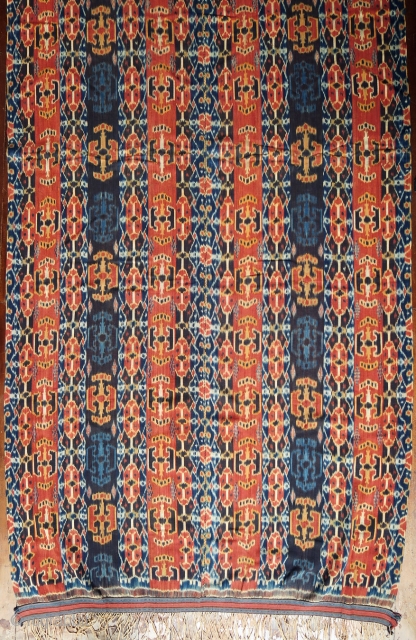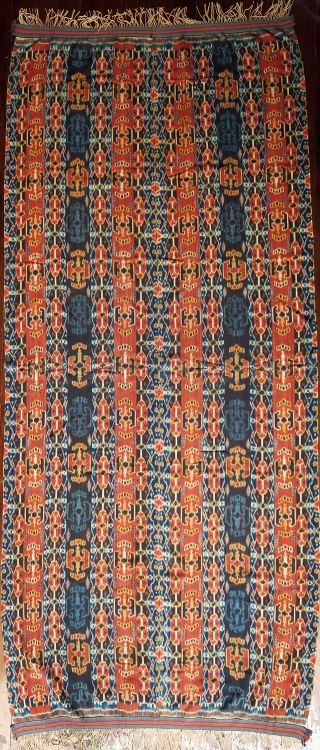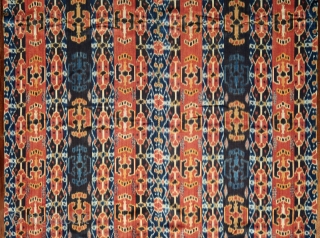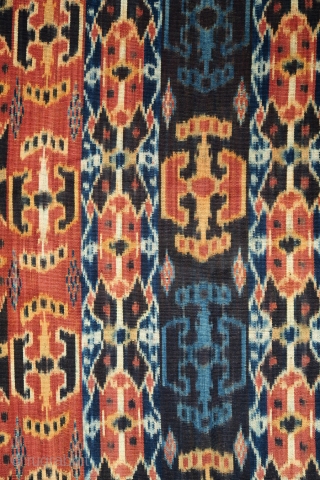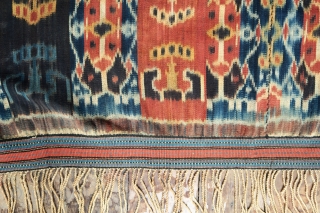Back
Sumba Ikat Men’s Mantle with Red Dye (Hinggi Kombu)
Indonesia, East Sumba, 1970-1990
Handspun cotton, commercial dyes, warp ikat, twining
Description: a modern example of one of the oldest ikat patterns for men’s mantles (hinggi) made in East Sumba, called patola ratu, that has a complex netting of geometric forms. The textile is constructed from 2 long identical panels hand-stitched together along the warp to form a double width. The primary motifs arranged in alternating red and blue-black columns are variations of the patola ratu motif which can be seen in its traditional form (a red shield-shaped motif), as the underlying basis of the design. a lattice of white diagonal lines, smaller internal diamonds of different sizes and shapes and an unusual amount of soft ochre yellow give the design a sparkling, animated effect. The textile is finished with a pleasing blue / red kabakil (a border of weft-wise rib woven on a special small loom, using the warps of the ikat as the wefts of the kabakil), and twisted fringes.
Context: Textiles from east Sumba have traditionally been major status markers for the noble caste throughout the island, who at one time had the sole right to wear decorated textiles. Their exchange substantiates alliances between clans, and is necessary to the rituals of the local animist belief system (Marapu). Large quantities are required as prestige clothing and gifts on ceremonial and ritual occasions—a high ranking Sumbanese may be wrapped and buried in over 100 hinggi, that will protect the soul from malevolent forces, and identify the deceased (by motifs, colors, and quality) to ancestors in the next world (Jill Forshee, “Unfolding Passages”, in Decorative Arts of Sumba, 33-39). The patola ratu design probably originated in Indian silk trade textiles, and was once reserved for the sole use of the ruler in some parts of Sumba.
The mantle is in excellent condition, with no holes, stains or tears. The colors are all rich and fresh, with warm, lively tones. The handspun cotton is of relatively light, densely woven, with a grainy hand.
Length: 260 cm plus 8 cm fringes at each end. Width: 115 cm.
Indonesia, East Sumba, 1970-1990
Handspun cotton, commercial dyes, warp ikat, twining
Description: a modern example of one of the oldest ikat patterns for men’s mantles (hinggi) made in East Sumba, called patola ratu, that has a complex netting of geometric forms. The textile is constructed from 2 long identical panels hand-stitched together along the warp to form a double width. The primary motifs arranged in alternating red and blue-black columns are variations of the patola ratu motif which can be seen in its traditional form (a red shield-shaped motif), as the underlying basis of the design. a lattice of white diagonal lines, smaller internal diamonds of different sizes and shapes and an unusual amount of soft ochre yellow give the design a sparkling, animated effect. The textile is finished with a pleasing blue / red kabakil (a border of weft-wise rib woven on a special small loom, using the warps of the ikat as the wefts of the kabakil), and twisted fringes.
Context: Textiles from east Sumba have traditionally been major status markers for the noble caste throughout the island, who at one time had the sole right to wear decorated textiles. Their exchange substantiates alliances between clans, and is necessary to the rituals of the local animist belief system (Marapu). Large quantities are required as prestige clothing and gifts on ceremonial and ritual occasions—a high ranking Sumbanese may be wrapped and buried in over 100 hinggi, that will protect the soul from malevolent forces, and identify the deceased (by motifs, colors, and quality) to ancestors in the next world (Jill Forshee, “Unfolding Passages”, in Decorative Arts of Sumba, 33-39). The patola ratu design probably originated in Indian silk trade textiles, and was once reserved for the sole use of the ruler in some parts of Sumba.
The mantle is in excellent condition, with no holes, stains or tears. The colors are all rich and fresh, with warm, lively tones. The handspun cotton is of relatively light, densely woven, with a grainy hand.
Length: 260 cm plus 8 cm fringes at each end. Width: 115 cm.
price:
USD 220
- Home
- Antique Rugs by Region
- Category
- Profiles
- Post Items Free
- Albums
- Benaki Museum of Islamic Art
- Budapest: Ottoman Carpets
- Gulbenkian Museum
- Islamic Carpets. Brooklyn
- Islamic Textiles. Brooklyn
- Konya Museum: Rugs
- MKG, Hamburg
- MMA: Caucasian Carpets
- MMA: Mamluk Carpets
- MMA: Mughal Indian Carpets
- MMA: Ottoman Carpets
- MMA: Safavid Persian Carpets
- MMA: Turkmen Rugs
- McCoy Jones Kilims
- Ottoman textiles. Met
- Philadelphia Museum
- Rugs and Carpets: Berlin
- Seljuqs at the Met
- TIEM, Istanbul: Carpets
- V&A: Classical Carpets
- Vakiflar Carpets: Istanbul
- Baluch Rugs: Indianapolis
- Gallery Exhibitions
- Jaf an Exhibition
- Alberto Levi Gallery
- Andean Textile
- Christie's London: 2016
- Francesca Galloway
- HALI at 40
- ICOC Washington, DC 2018
- Jajims of the Shahsavan
- London Islamic Week April, 2018
- Mongolian Felts
- Navajo Rugs: JB Moore
- Persian Piled Weavings
- SF Tribal & Textile Art Show 2020
- SF Tribal 2019
- Sotheby's: C. Alexander
- Turkish Prayer Rugs
- Turkmen Main Carpets ICOC 2007










